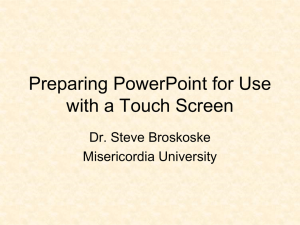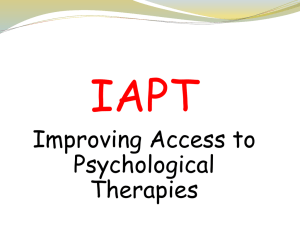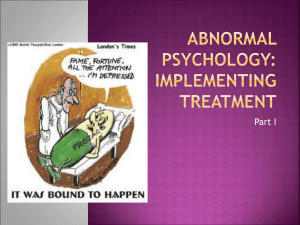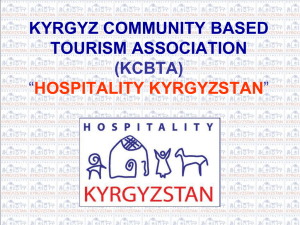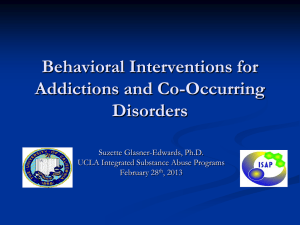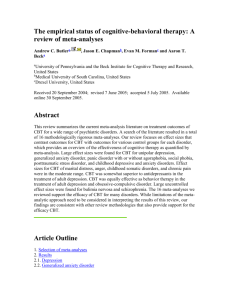Delivering Group CBT
advertisement
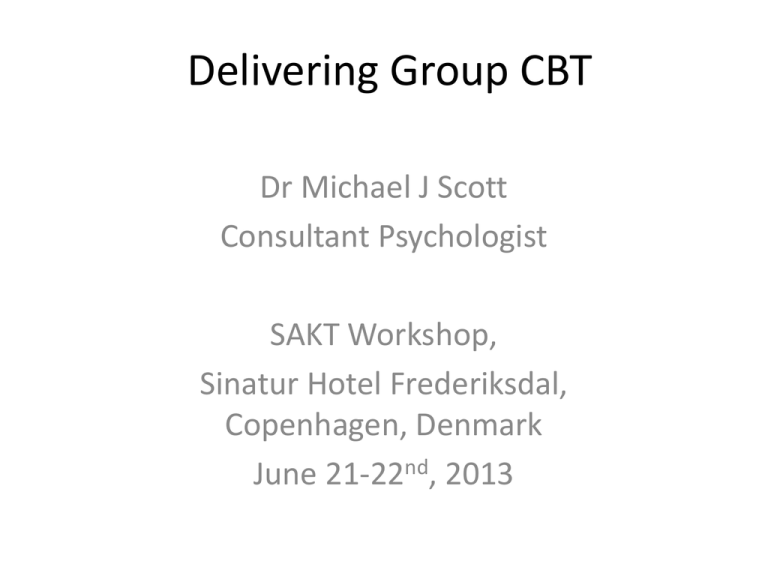
Delivering Group CBT Dr Michael J Scott Consultant Psychologist SAKT Workshop, Sinatur Hotel Frederiksdal, Copenhagen, Denmark June 21-22nd, 2013 Learning Objectives 1. 2. 3. 4. 5. 6. 7. 8. How to assess clients for GCBT How to market GCBT How to engage clients in GCBT How to deliver evidence-based GCBT protocols for depression and the anxiety disorders How to manage group processes How to assess group skills How to deal with complex cases How to troubleshoot difficulties Resources • Scott, M. J (2011) Simply Effective Group Cognitive Behaviour Therapy: A Practitioners guide. London: Routledge. Free self-help manuals for depression and the anxiety disorders are available at www.routledgementalhealth.com/simply-effective-group-cognitivebehaviour-therapy-978041557342 and are the basis for the group programmes (they can also be used for individual therapy). • Wenzel, A., Liese, B.S., Beck, A.T and Friedman-Wheeler (2012) Group Cognitive Therapy for Addictions. New York: Guilford Press. • Bieling, P.J, McCabe, R.E and Anthony, M.M (2009) Cognitive –Behavioral Therapy in Groups. New York: Guilford Press. Who is interested in doubling the staff of their Department, at no extra cost? Group CBT Cuts the Cost of Providing Therapy by 40-50% Compared to Individual Therapy • Scott and Stradling (1990) Group Cognitive Therapy for Depression Produces clinically Significant Reliable Change in Community-based Settings. Behavioural Psychotherapy, 1, 1-19 • Sobell, Sobell and Agrawal (2009) Randomized controlled trial of a cognitive-behavioral maturational intervention in a group versus individual format for substance use disorders. Psychol Addict Behavior, 23, 672-683 Group and Individual CBT Appear Equally Effective for Depression and the Anxiety Disorders • Depression Tucker and Oei (2007) five studies showed the superiority of ICBT over GCBT and five showed the equivalence of the two modalities • Social phobia ‘ it is difficult to come to any firm conclusions about the relative effectiveness of ICBT and GCBT’ P3 Scott (2011) • Panic disorder Sharp, Power and Swanson (2004) showed ICBT and GCBT to be equally effective • PTSD both modalities can be equally effective Beck et al (2009) • GAD both modalities can be equally effective Dugas et al (2009) • OCD ‘GCBT is an effective treatment for OCD but often, it seems, less so than ICBT’p5 Scott (2011) Group and Individual CBT Also Appear Equally Effective for Bulimia • Katzman et al (2010) concluded ‘outcome differences between individual and group CBT were minor, suggesting that group treatment prefaced by a short individual intervention may be a cost-effective alternative to purely individual treatment’ Psychosomatic Medicine 72: 656-663. Group based behavioural and cognitive-behavioral parenting interventions are effective for reducing child conduct problems in 3-12 year olds • See Furlong et al (2012) meta analyses of 13 trials. Cochrane Database Syst Rev 2:CD008225 • Parent training programmes were also found to improve parental mental health • Scott, M. J and Stradling, S. G (1987) Behavioural Psychotherapy, 15: 224-39 The evaluation of a group parent training programme If CBT is primarily about teaching skills, it is an anachronism that groups are the exception We need to go beyond treating the tip of the iceberg Given that GCBT results in a greater throughput of clients, it is perhaps surprising that clients predominantly undergo individual CBT Why then is GCBT such a rarity? GCBT Has Not Been Encouraged In Supervision • In Simply Effective CBT Supervision Scott (2013) London: Routledge, suggests that the primary purpose of supervision is to act as a conduit for evidence-supported treatments • Until Supervisors take GCBT on board it is not going to happen • The same process skills that are used in GCBT can be applied to group supervision Is this the horror video that puts therapists off running a group? Perhaps we need to replace it by a reality video, grounded in everyday experience? Group CBT mirrors the everyday, but is in addition educational Assessing Clients for GCBT Why bother? Evidence-based GCBT • Predominantly diagnosis specific • Most compelling evidence for depression and the anxiety disorders • Very limited evidence that it is possible to focus on more than one disorder within a group • Some evidence that can combine individual and GCBT Problems of Engagement • If clients are given a free choice between GCBT and ICBT the overwhelming majority 95%in Sharp et al’s (2004) study of panic disorder clients will opt for individual therapy • Thompson et al (2009) found that factor half of the people invited to consider attending a PTSD group chose not to do so • In a study of GCBT for OCD [O’Connor et al (2005) ]38% of clients refused treatment in group format Making GCBT Tempting ‘You are not alone’ – classes and individual tuition for your nerves in just three steps Complete the ‘What’s up? Questionnaire Choose a Survival Manual, have a read to see how someone just like you has moved on Join a class to go into the Manual in detail Engagement • Direct client access, phone call returned within on average 8 hours, use of 7-Minute Interview to screen for all common disorders, detailing of problems, appointment for detailed inquiry with same therapist if possible • Face to face interview, detailed inquiry about positive screens, personality problems • Normalising distress ‘others with same problem we teach special ways of handling this’ • Motivational ruler • The ‘carrot’ of individual sessions • Addressing comorbidity The 7-Minute Interview Revised - Extract 1. Depression Yes No Don’t know During the past month have you often been bothered by feeling depressed or hopeless? During the past month have you often been bothered by little interest or pleasure in doing things? Is this something with which you would like help? A positive response to at least one symptom question and the help question suggests that detailed enquiry be made The 7-Minute Interview Revised – Further Extract 8. Substance abuse/dependence Yes No Have you felt you should cut down on your alcohol/drug? Have people got annoyed with you about your drinking/drug taking? Have you felt guilty about your drinking/drug use? Do you drink/use drugs before midday? Is this something with which you would like help? A positive response to at least two of the symptom questions and the help question suggests that detailed enquiry be made. Don't know Making a Diagnosis 1. The CBT Pocketbook, from Simply Effective Group CBT, is used after first screening clients for possible disorders 2. For each disorder there are questions which directly access each symptom in the DSM-IV-TR criteria 3. For a symptom to be regarded as present it must produce clinically significant distress or impairment 4. When there is a need to reassess the client, the same questions can be asked again to check progress Screening for Personality Disorder Only circle Y (yes) or N (no), in the case of question 3, if the client thinks that the description applies most of the time and in most situations. 1. In general, do you have difficulty making and keeping friends? . . . Y/N (yes = 1, no = 0) 2. Would you normally describe yourself as a loner? . . . . . . . . . . . . . . Y/N (yes = 1, no = 0) 3. In general, do you trust other people?. . . . . . . . . . . . . . . . . . . . . . . . . Y/N (yes = 0, no = 1) 4. Do you normally lose your temper easily? . . . . . . . . . . . . . . . . . . . . . Y/N (yes = 1, no = 0) 5. Are you normally an impulsive sort of person? . . . . . . . . . . . . . . . . . Y/N (yes = 1, no = 0) 6. Are you normally a worrier?. . . . . . . . . . . . . . . . . . . . . . . . . . . . . . . . . Y/N (yes = 1, no = 0) 7. In general, do you depend on others a lot? . . . . . . . . . . . . . . . . . . . . Y/N (yes = 1, no = 0) 8. In general, are you a perfectionist? . . . . . . . . . . . . . . . . . . . . . . . . . . . Y/N (yes = 1, no = 0) In Simply Effective Group CBT suggested a score of 5 or more should be used to exclude from GCBT Assessing Motivation – Readiness for a Group Please circle a number, on the ruler below, to indicate how ready you feel to join a group of others with your difficulties, to learn new ways of handling your problems. No 1 2 Maybe 3 4 5 6 Yes 7 8 9 If you indicated a `No' or `Maybe' number above, what is it that puts you off joining a group? .............................................................. ............................................................... ............................................................... 10 A Credible Rationale – Disorder Specific Survival Manual (freely available at www.routledgementalhealth.com/simply-effective-groupcognitive-behaviour-therapy-978041557342) • Clarifies the content of sessions – ‘we will be working through the Manual’ • Normalises the client’s problems • Individualises the client’s problems – ‘read through see what resonates’ • Enhances self-efficacy by suggesting manageable first steps • Address the whole range of client concerns/diagnoses by the provision of a Manual for each disorder Extract of a Survival Manual - PTSD 3. Better ways of handling the traumatic memory You have probably tried to blank the memory, distracting yourself by doing something or talking to someone. Trouble is that that works only briefly. Here is why: supposing if I said `Do not think about the orangutan‘ Continuation of Extract from PTSD Survival Manual As you continue to read you are still thinking of orangutans (perhaps you think he looks like somebody you know!). The more you try to deliberately not think of something the more you think about it. Structure of a Group Session 1. Welcome over coffee/tea/fruit juice 2. Review of homework 3. Introduction of new material 4. Setting of individualised homework incorporating new learning General Group Therapeutic Skills Rating Scale 1. 2. 3. 4. 5. 6. 7. 8. 9. Review of homework/agenda Relevance Adaptation Inclusion Additional disorders Magnifying support and minimising criticism Utilising group members as role models Therapist presentation skills Addressing group issues The Determinants of Effective GCBT Depression Programme Extract Mood Chart Monitor Mood – how I am feeling now Observe thinking – what I am saying to myself to feel the way I feel Objective Decide what thinking –a to do and do better way of it – don’t thinking stew, get on about it is and do Information Processing Biases 1. Dichotomous (black and white) thinking, e.g. `I'm either a total success or a failure'. 2. Mental filter, focusing on the negative to the exclusion of the positive, e.g. `how can you say it was a lovely meal, how long did we have to wait for the dessert to be served?‘ 3. Personalisation, assuming just because something has gone wrong it must be your fault, e.g. `John did not let on to me coming into work this morning, must have been something I said'. 4. Emotional reasoning, assuming guilt simply because of the presence of guilt feelings, e.g. `I can't provide for the kids the way I did, I've let them down, what sort of parent am I?' 5. Jumping to conclusions, e.g. assuming that being asked to have a word with your line manager means that you are in trouble. Contd. Information Processing Biases contd. 6. Overgeneralisation, making negative predictions on the basis of one bad experience, e.g. `I've had it with men after Charlie, you cannot trust any of them'. 7. Magnifcation and minimisation, magnifying faults or difficulties, minimising strengths or positives, e.g. `I am terrible at report writing and I am lucky to have got good appraisals for the last couple of years'. 8. Disqualifying the positives, e.g. brushing aside compliments and dwelling on criticism. 9. `Should' statements, overuse of moral imperatives, e.g. `I must do . . . I should . . . I have to . . .'. 10. Labelling and mislabelling, e.g. `if I make a mistake I am a failure as a person'. Dissemination • See one • Assist with one • Do one The Advantages of Having A Co-leader • It is possible to run a group with a sole therapist but it is easier with a co-leader • With two therapists one of you is likely to be able to take over if the other becomes stuck • If one group member is having particular difficulty e.g becomes too distressed to focus on the content of the session, the co-leader can take him/her to one side • It is easier to individualise homework assignments with two therapists • It is easier to address co-morbidity outside the session • Having a co-leader is an aid to dissemination Working Synergistically with a Co-leader • Both therapists need to agree in advance who is doing what • Therapists can give each other feedback on their performance • Both can troubleshoot how to resolve difficulties in the group • It is useful for the two therapists to sit opposite each other • It can be useful to have a therapist sit next to a particularly troublesome group member Addressing Comorbidity Most clients have more than one disorder, additional disorders can be addressed by telephone/email/texts between sessions using the pertinent Survival Manual or other self-help materials Diversity in Group Approaches • Group interventions have focussed exclusively on closed i.e timelimited groups, the only exception to this is the Sobell, Sobell and Agrawal (2009) open group for addicts. The rationale Sobell and colleagues give for this is that addiction is a chronic condition, rather like diabetes and there will always be a need to revisit the problem and that this is different to acute conditions like depression, OCD. • Scott and Stradling (1990) offered up to three individual sessions running alongside the depression group • Katzman et al (2010) offered four individual sessions before the eight session group programme for bulimia. Further they broadened the diagnostic criteria for bulimia to include clients who met diagnostic criteria for Eating Disorder Not Otherwise Specified. ‘Mixed Groups?’ • A single focus on what is common in the group helps group cohesion • Groups are easier if they are homogenous – if too many disorders are the focus there is a danger of not addressing any one disorder in sufficient depth. Arch et al (2013) [BRAT 51, 185-196] ran a CBT group admitting all clients who were troubled most by any anxiety disorder, only half (57%) completed treatment and only half (53%) showed a reliable and clinically significant change by the end of treatment. • But there is some evidence that a limited transdiagnostic approach e.g panic disorder/social phobia Norton (2007) can work How Important is Group Process? • GCBT studies have been conducted without an explicit focus on group process, but this does not mean that therapists were not mindful of them, for example would not go out of their way to include a group member who seemed to take up little ‘air-time’ • GCBT may work for reasons other than the same material delivered in individual format • We do not know the relative importance content and process, intuitively they seem both important Improving Access to GCBT • • • • • Where are we now? Where do we want to get to? How do we nudge GCBT onto the agenda? What would be the first step? What obstacles are there in the way of completing the first step? • How might we step around the first obstacles? • How will we ensure that we keep moving forward? Danish Group CBT for Bulimia Study • Jones and Clausen (2013) Int J Eating Diord • 8 session GCBT • Significant reductions in eating disorder pathology were found on all measures of bulimia related behavioral symptoms, as well as on all measures of bulimia related distress On the 200th Anniversary of the birth of Soren Kierkegaard, Danish Philosopher, some of his quotes – I think he got there before CBT! • ‘To dare is to lose one’s footing momentarily. Not to dare is to lose oneself’ • ‘Our life always expresses the result of our dominant thoughts’ • ‘Don’t forget to love yourself’ • ‘A man who as a physical being is always turned toward the outside, thinking that his happiness lies outside him, finally turns inward and discovers that the source is within him’



